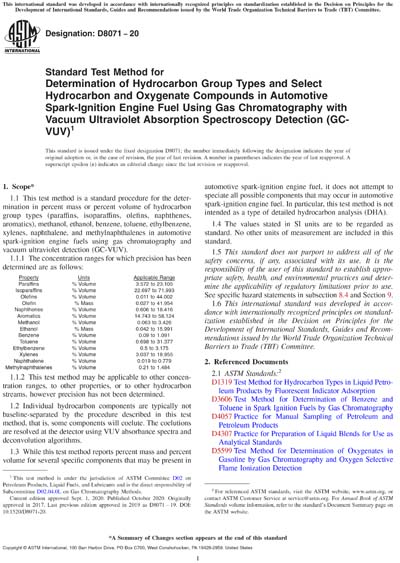Historical
ASTM D8071-20
Standard Test Method for Determination of Hydrocarbon Group Types and Select Hydrocarbon and Oxygenate Compounds in Automotive Spark-Ignition Engine Fuel Using Gas Chromatography with Vacuum Ultraviolet Absorption Spectroscopy Detection (GC-VUV)
1.1 This test method is a standard procedure for the determination in percent mass or percent volume of hydrocarbon group types (paraffins, isoparaffins, olefins, naphthenes, aromatics), methanol, ethanol, benzene, toluene, ethylbenzene, xylenes, naphthalene, and methylnaphthalenes in automotive spark-ignition engine fuels using gas chromatography and vacuum ultraviolet detection (GC-VUV).
1.1.1 The concentration ranges for which precision has been determined are as follows:
1.1.2 This test method may be applicable to other concentration ranges, to other properties, or to other hydrocarbon streams, however precision has not been determined.
1.2 Individual hydrocarbon components are typically not baseline-separated by the procedure described in this test method, that is, some components will coelute. The coelutions are resolved at the detector using VUV absorbance spectra and deconvolution algorithms.
1.3 While this test method reports percent mass and percent volume for several specific components that may be present in automotive spark-ignition engine fuel, it does not attempt to speciate all possible components that may occur in automotive spark-ignition engine fuel. In particular, this test method is not intended as a type of detailed hydrocarbon analysis (DHA).
1.4 The values stated in SI units are to be regarded as standard. No other units of measurement are included in this standard.
1.5 This standard does not purport to address all of the safety concerns, if any, associated with its use. It is the responsibility of the user of this standard to establish appropriate safety, health, and environmental practices and determine the applicability of regulatory limitations prior to use. See specific hazard statements in subsection 8.4 and Section 9.
1.6 This international standard was developed in accordance with internationally recognized principles on standardization established in the Decision on Principles for the Development of International Standards, Guides and Recommendations issued by the World Trade Organization Technical Barriers to Trade (TBT) Committee.
Content Provider
ASTM International [astm]






